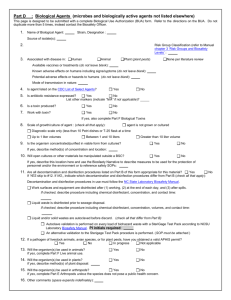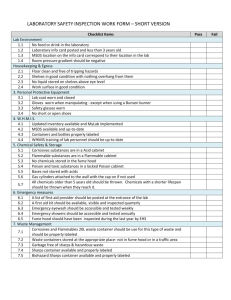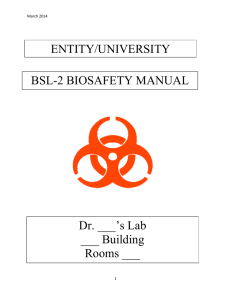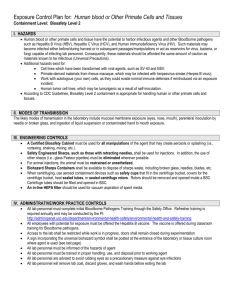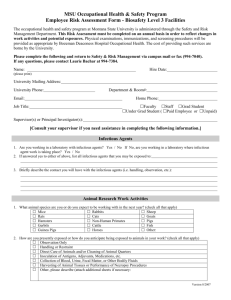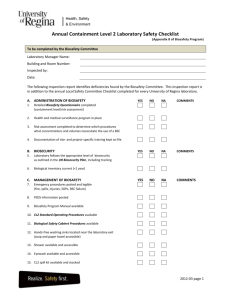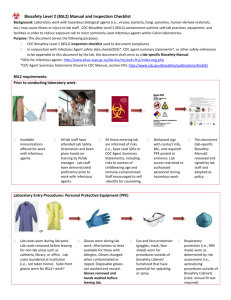Biosafety Manual
advertisement
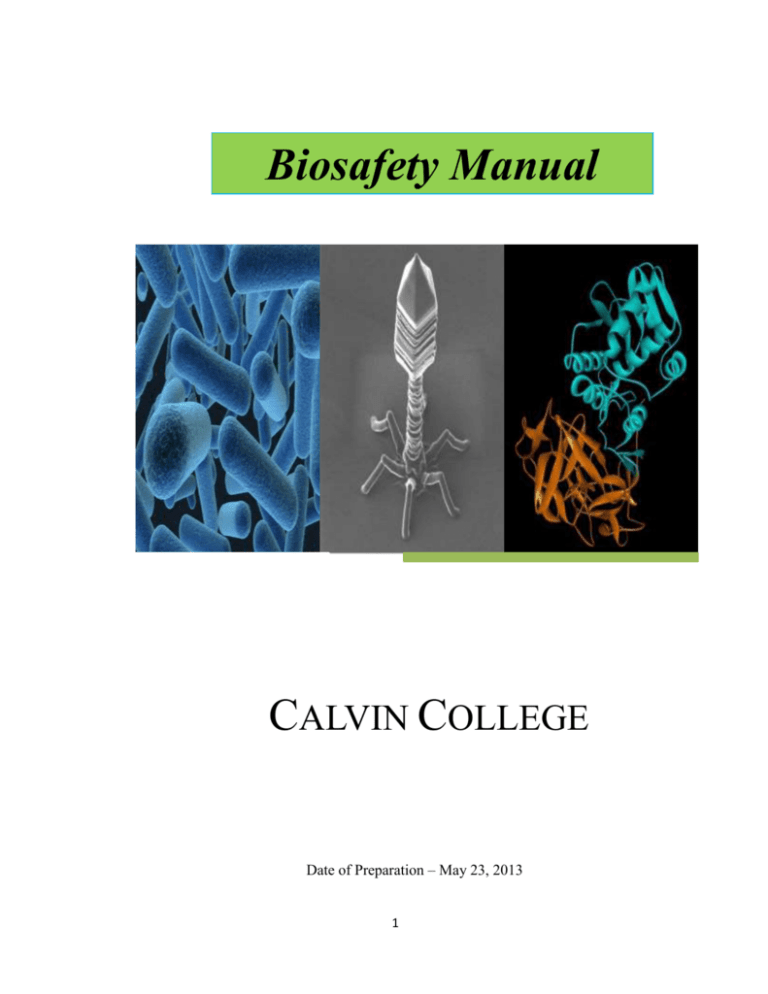
Biosafety Manual CALVIN COLLEGE Date of Preparation – May 23, 2013 1 TABLE OF CONTENTS PURPOSE………………………………………………………………….. 3 POLICY…………………………………………………………………… 3 RESPONSIBILITIES………………………………………………………… 3 GENERAL INFORMATION…………………………………………………. 4 BIOSAFETY CONTAINMENT LEVELS……………………………………… 6 INJURIES………………………………………………………………….. 9 DECONTAMINATION & DISPOSAL………………………………………... 9 EMERGENCY PROCEDURES………………………………………………. 12 USE & DISPOSAL OF SHARPS…………………………………………….. 14 BIOSAFETY EQUIPMENT…………………………………………………. 15 SHIPMENT OF BIOLOGICAL MATERIAL…………………………………... 17 TRAINING………………………………………………………………… 19 IMPORTANT PHONE NUMBERS EMERGENCY TELEPHONE NUMBER Campus Safety Emergency Line (from a cell phone, call 526-3333) ASSISTANCE TELEPHONE NUMBERS Department of Environmental Health & Safety Biosafety Officer 3-3333 6-8591 6-6080 USEFUL WEBSITES NIH Guidelines for Research Involving Recombinant or Synthetic Nucleic Acid Molecules http://oba.od.nih.gov/oba/rac/Guidelines/NIH_Guidelines.htm Biosafety in Microbiological and Biomedical Laboratories (5th edition): http://www.cdc.gov/biosafety/publications/bmbl5/ NIH Office of Biotechnology Activities: http://oba.od.nih.gov/oba/index.html National Select Agent Program: http://www.selectagents.gov/ CDC Permit to Import or Transport Etiologic Agents: http://www.cdc.gov/od/eaipp/ Selection, Installation, and Use of Biological Safety Cabinets: http://www.cdc.gov/biosafety/publications/bmbl5/BMBL5_appendixA.pdf 2 I. PURPOSE This Calvin College policy will establish the process for compliance with the following documents: NIH Guidelines for Research Involving Recombinant and Synthetic Nucleic Acid Molecules (NIH Guidelines), current edition; Biosafety in Microbiological and Biomedical Laboratories (BMBL), current edition. II. POLICY Calvin College committed to preserving the health and safety of its students, staff, and faculty, and to protecting the environment and the community. It is recognized that use of potentially pathogenic microorganisms and organisms containing recombinant or synthetic nucleic acid molecules (r/sNA) is necessary in many university research and teaching laboratories. To ensure the safe handling of these organisms, the College requires compliance with the NIH Guidelines and with the recommendations in BMBL. Compliance with other applicable federal, state, and local regulations is also required. III. RESPONSIBILITIES The Principal Investigator (PI) is directly and primarily responsible for the safe operation of the laboratory. His/her knowledge and judgment are critical in assessing risks and appropriately applying the recommendations in this manual. However, safety is a shared responsibility among all of the laboratory staff. Many resources exist to assist the PI with these responsibilities, including the Biological Officer (BSO), the Institutional Biosafety Committee (IBC), and the Department of Environmental Health & Safety (EHS). EHS & the BSO shall: Prepare the Biosafety Manual, with revisions as necessary; Ensure each faculty member who works with biological materials is familiar with this manual; Review research involving biohazardous materials conducted at or sponsored by the College for compliance with the guidelines in Biosafety in Microbiological and Biomedical Laboratories (BMBL), and approve those research projects that are found to conform with the recommendations in BMBL; Investigate accidents involving infectious agents; Collect and dispose of Biological Waste; Provide or coordinate biosafety training as necessary or as requested; Assist investigators with risk assessment; and Administer all elements of the Biosafety Program, assist faculty with submission of registrations to the IBC, and maintain registration files. PIs shall: Assess the risks of their experiments; 3 Ensure the safe operation of their laboratory (can seek assistance from EHS or BSO); Train laboratory personnel in safe work practices; Comply with all applicable state and federal regulations and guidelines; Register the following experiments with the IBC as required: o Recombinant and synthetic nucleic acid activities (even if exempt): o Work with biohazardous materials such as: Bacteria , viruses and other potentially infectious agents Biologically active agents such as toxins, venoms and allergens Human blood or other potentially infectious materials such as unfixed human tissues. Animal and plant pathogens. The IBC shall: Review recombinant and synthetic nucleic acid research conducted at or sponsored by the College for compliance with the NIH Guidelines, and approve those research projects that are found to conform with the NIH Guidelines; Notify the PI of the results of the IBC’s review and approval; Report any significant problems with or violations of the NIH Guidelines and any significant research-related accidents or illness to the appropriate Institutional official and to the NIH Office of Biotechnology Activities (OBA) within 30 days; and Follow the guidelines for membership defined by NIH. Laboratory personnel shall: Comply with safety recommendations for the work being performed; and Report accidents or injuries to the PI. IV. GENERAL INFORMATION EHS will assist any Department in providing training and guidance for implementation of this policy. Registration forms and the publications referenced in Section I above are available through the EHS web site. CLASSIFICATION OF BIOHAZARDOUS MATERIAL Procedures and facilities involved in protecting laboratory workers, the public, and the environment from laboratory biological hazards are governed by federal and state regulations and guidelines. Many granting agencies require that grant recipients certify that they adhere to both the guidelines and the regulations. See the glossary at the end of this policy for more detailed information on microorganisms. Registration Document Each PI is responsible for registering all experiments involving biohazardous materials and recombinant and synthetic DNA. Online registration (Biosafety Application) is available through the EHS website – search the Biosafety link. The BSO & EHS audit all laboratories 4 where BSL2 containment is required, and all BSL1 laboratories which are subject to the NIH Guidelines. Review and Approval of Experiments The IBC, which oversees r/sNA research at Calvin College, or the BSO will review and approve the registration. RISK ASSESSMENT "Risk" implies the probability that harm, injury, or disease may occur. In the context of microbiological and biomedical laboratories, the assessment of risk focuses primarily on prevention of laboratory-associated infections (LAIs). When addressing laboratory activities involving biohazardous materials, risk assessment is a critical exercise that assigns an appropriate biosafety level (facilities, equipment, and practices) in order to reduce exposure risk and environmental threat of laboratory staff to an acceptable minimum. The intent of this section is to provide guidance and to establish a framework for selecting the appropriate biosafety level. The PI is responsible for assessing risks in order to set appropriate biosafety levels. This process should be conducted in close collaboration with the IBC to ensure compliance with established guidelines and regulations. Determining factors in risk assessment include: 1. Pathogenicity of the infectious agent pertaining to disease frequency and severity (i.e., mild morbidity versus high mortality, acute versus chronic disease). The more severe the disease, the greater the risk associated with that pathogen. 2. Route of transmission (e.g., parenteral, airborne, or by ingestion) with novel agents may not be definitively established. Extensive epidemiological research has indicated that agents readily transmitted via aerosol route have caused most laboratory-associated infections making critical the consideration of aerosol transmission potential of novel agents. The greater the potential for aerosolization, the higher the risk of transmission, and correspondingly, the higher the required biosafety level. 3. Agent stability is the consideration of an agent's ability to survive over time in the environment. Factors such as desiccation, temperature, exposure to ultraviolet light, and exposure to chemical disinfectants must be considered. 4. Infectious dose can vary from one to hundreds of thousands of infectious units. There is a complex interaction between pathogen and host and the resultant issues present a significant challenge even to the healthiest immunized laboratory worker and may pose a serious risk to those with lesser resistance. The laboratory worker's immune status is directly related to his/her susceptibility to disease when working with an infectious agent. 5. Health status of worker plays a role in risk. Be sure to inform lab employees of risks associated with research so that the employee can determine the need for further consult with their physician or Calvin’s occupational medical provider (contact Heather @ 68591 for an appointment with Med-1). At a minimum, to reduce the risk of occupationally acquired bloodborne disease, employees with a reasonably anticipated potential for exposure to human blood and its components, human bodily fluids, or other human tissues (including cell lines) must participate in Calvin’s BBP Program and be offered the hepatitis B vaccine. Immunization for other potentially infectious agents may be required after risk assessment by EH&S, the BSO, the IBC, and the PI. In this instance, a waiver must be signed if the employee declines to be vaccinated after being informed of the risks versus benefits of immunization. 5 6. The concentration (number of infectious particles per unit volume) is important in determining risk of infection. Items to consider are the milieu containing the organism (e.g., solid tissue, viscous blood or sputum; or liquid medium), volume of concentrated material, and the laboratory activity planned (e.g., agent amplification, sonication, or centrifugation). 7. The origin of infectious materials is critical when preparing a risk assessment. "Origin" may refer to geographic location (e.g., domestic or foreign); host (e.g., infected or uninfected human or animal); or nature of source (potential zoonotic or associated with a disease outbreak). 8. The established availability of an effective prophylaxis or therapeutic intervention is an essential factor to be considered. The most common form of prophylaxis is immunization. 9. Medical surveillance ensures that the safeguards implemented produce the desired health outcomes. Medical surveillance is part of risk management and may include serum banking, monitoring employee health status, and participating in post-exposure management. 10. The availability of data from animal studies, in the absence of human data, may provide useful information in a risk assessment. V. BIOSAFETY CONTAINMENT LEVELS Four levels of biosafety are defined in the publication Biosafety in Microbiological and Biomedical Laboratories (BMBL), published by the CDC and NIH. The levels, designated in ascending order by degree of protection provided to personnel, the environment, and the community, are combinations of laboratory practices, safety equipment, and laboratory facilities (see Appendices). Microbiological work at Calvin College is conducted at BSL1 or BSL2 containment. There are no BSL3 or BSL4 laboratories at the College. Below is a summary of biosafety levels 1 and 2; detailed criteria for each level are described online at CDC BMBL. Biosafety Level 1 is suitable for work involving well-characterized agents not known to consistently cause disease in immunocompetent adult humans, and present minimal potential hazard to laboratory personnel and the environment. BSL-1 laboratories are not necessarily separated from the general traffic patterns in the building. Work is typically conducted on open bench tops using standard microbiological practices. Special containment equipment or facility design is not required, but may be used as determined by appropriate risk assessment. Laboratory personnel must have specific training in the procedures conducted in the laboratory and must be supervised by a scientist with training in microbiology or a related science. Biosafety Level 2 practices, equipment, and facility design and construction are applicable to clinical, diagnostic, teaching, and other laboratories in which work is done with the broad spectrum of indigenous moderate-risk agents that are present in the community and associated with human disease of varying severity. With good microbiological techniques, these agents can be used safely in activities conducted on the open bench, provided the potential for producing splashes or aerosols is low. Hepatitis B virus, HIV, the salmonellae, and Toxoplasma spp. are representative of microorganisms assigned to this containment level. BSL-2 is appropriate when work is done with any human-derived blood, body fluids, tissues, or primary human cell lines where the presence of an infectious agent may be unknown. (Laboratory personnel working with human-derived materials should refer to the OSHA Bloodborne Pathogen Standard 2 for specific required precautions). Primary hazards to 6 personnel working with these agents relate to accidental percutaneous or mucous membrane exposures, or ingestion of infectious materials. Extreme caution should be taken with contaminated needles or sharp instruments. Even though organisms routinely manipulated at BSL-2 are not known to be transmissible by the aerosol route, procedures with aerosol or high splash potential that may increase the risk of such personnel exposure must be conducted in primary containment equipment, or in devices such as a BSC or safety centrifuge cups. Personal protective equipment should be used as appropriate, such as splash shields, face protection, gowns, and gloves. Secondary barriers such as hand washing sinks and waste decontamination facilities must be available to reduce potential environmental contamination. 7 Summary of Recommended Biosafety Levels BSL AGENTS PRACTICES PRIMARY BARRIERS AND SAFETY EQUIPMENT FACILITIES (SECONDARY BARRIERS) 1 Not known to consistently cause diseases in healthy adults Agents associated with human disease. Routes of transmission include percutaneous injury, ingestion, mucous membrane exposure. Standard Microbiological Practices None required. Laboratory bench and sink required. BSL-1 practices plus: Limited access Biohazard warning signs “Sharps” precautions Biosafety manual defining any needed waste decontamination or medical evaluation program BSL-2 practices plus: Controlled access Decontamination of all waste Decontamination of laboratory clothing before laundering Baseline serum Primary barriers: Class I or II BSCs or other physical containment devices used for all manipulations of agents that cause splashes or aerosols of infectious materials PPE: Laboratory coats; gloves; face protection as needed Primary barriers: Class I or II BSCs or other physical containment devices used for all open manipulation of agents PPE: Protective laboratory clothing; gloves; respiratory protection as needed Primary barriers: All procedures conducted in Class III BSCs or Class I or II BSCs in combination with full-body, airsupplied, positive pressure personnel suit BSL-2 plus: Autoclave available 2 3 Indigenous or exotic agents with potential for aerosol transmission Disease may have serious or lethal consequences 4 Dangerous/exotic agents which pose high risk of lifethreatening disease Aerosoltransmitted laboratory infections have occurred; or related agents with unknown risk of transmission BSL-3 practices plus: Clothing change before entering Shower on exit All material decontaminated on exit from facility 8 BSL-2 plus: Physical separation from access corridors Self-closing, double-door access Exhaust air not recirculated Negative airflow into laboratory BSL-3 plus: Separate building or isolated zone Dedicated supply and exhaust, vacuum, and decontamination systems Other requirements outlined in the text VI. INJURIES For Severe Injuries Call Campus Safety (3-3333 from Calvin land line; or 616-526-3333 from cell phone) for assistance and transportation to the nearest emergency room. Report accident to the PI and EHS immediately. If required, send injured employee to Med-1, Calvin’s occupational medical provider. Be sure to have an Injury Report Form filled out and relay details of the exposure to the medical professional. An authorization form for treatment can be obtained from EHS at the Physical Plant. For Splash To The Eye Immediately flush the eye with a gentle stream of clean, temperate water for 15 minutes. Hold the eyelid open. Be careful not to wash the contaminant into the other eye. Use an emergency eyewash if one is accessible. Contact Campus Safety for medical first response (3-3333 from Calvin land line; or 616526-3333 from cell phone). Report the accident to the PI and EHS, and seek additional medical assistance if necessary at Calvin’s medical provider, Med-1. An authorization form for treatment can be obtained from EHS at the Physical Plant. For Contamination To The Body Immediately remove contaminated clothing and drench skin with water. Wash with soap and water, and flush the area for 15 minutes. Contact Campus Safety for medical first response (3-3333 from Calvin land line; or 616526-3333 from cell phone). Report the accident to the PI and EHS, and seek additional medical assistance if necessary at Calvin’s medical provider, Med-1. An authorization form for treatment can be obtained from EHS at the Physical Plant. FIRES INVOLVING BIOLOGICAL MATERIALS Without placing yourself in danger, put biological materials in secure location, such as incubator or freezer. Activate the building fire alarm. Leave the building at once. Call Campus Safety (616-526-3333) from a safe location and provide details of the fire. Any individual who receives an exposure or potential exposure will be given a medical consultation and advised of available treatments. VII. DECONTAMINATION & DISPOSAL Sterilization, disinfection, and antisepsis are all forms of decontamination. Sterilization implies the killing of all living organisms. Disinfection refers to the use of antimicrobial agents on 9 Biosafety Manual | Calvin College inanimate objects; its purpose is to destroy all non-spore forming organisms. Antisepsis is the application of a liquid antimicrobial chemical to living tissue. a. DISINFECTION & STERILIZATION Chemical disinfectants are used to render a contaminated material safe for further handling, whether it is a material to be disposed of as waste, or a laboratory bench on which a spill has occurred. It is important to choose a disinfectant that has been proven effective against the organism being used. Chemical disinfectants are registered by the EPA under the following categories: o Sterilizer or Sterilant - will destroy all microorganisms including bacterial and fungal spores on inanimate surfaces. o Disinfectant - will destroy or irreversibly inactivate specific viruses, bacteria, and pathogenic fungi, but not bacterial spores. o Hospital Disinfectant - agent shown to be effective against S. aureus, S. choleresis and P. aeruginosa. It may be effective against M. tuberculosis, pathogenic fungi or specifically named viruses. o Antiseptic - agent formulated to be used on skin or tissue - not a disinfectant. b. BIOLOGICAL WASTE DISPOSAL PROCEDURES Biological Waste o All biological waste from BSL1 and BSL2 laboratories must be decontaminated prior to disposal. o Proper storage, collection and handling are the responsibility of the person/laboratory generating the waste. The lab supervisor shall collect disposable, solid materials contaminated by an infectious agent, excluding sharps, or broken or unbroken glass, into an autoclave bag within a sturdy container. When full, these bags are autoclaved, cooled, and then placed in the general waste stream. o Autoclaving is the primary means of decontaminating equipment and tools. If this method is not used, then decontaminate liquids containing a biological agent by the addition of a chemical disinfectant such as sodium hypochlorite (household bleach) or an iodophor, then dispose of by pouring down the sink (it is not necessary to autoclave liquids that have been chemically disinfected). However, if a bleach solution has been used in the collection tray for labware that will later be autoclaved, sodium thiosulfate must be added to the bleach to prevent the release of chlorine gas during autoclaving. Reusable Labware o 10 Items such as culture flasks and centrifuge bottles are decontaminated by lab personnel before washing by one of two methods: o Autoclave items that have been collected in autoclavable container or o Chemically disinfect items by soaking in diluted disinfectant for one hour before washing. Biosafety Manual | Calvin College Disposal of Blood Products and Body Fluids o All human blood and other potentially infectious materials (OPIM) should be handled using Universal Precautions. o Discard disposable items contaminated with human blood or body fluids (excluding sharps and glassware) into the incinerator boxes that are available from the Biology Dept Lab Manager or EHS. Do not overfill boxes or use without the plastic liners provided with them. These boxes may be used for temporary storage and accumulation of waste. When full, close and seal the plastic liner and box. o The Biology Lab Manager will collect and dispose of all incinerator boxes. Disposal of Sharps and Disposable Glassware o Discard all needles, needle and syringe units, scalpels, and razor blades, whether contaminated or not, directly into rigid, red, labeled sharps containers. Do not recap, bend, remove or clip needles. Sharps containers should not be overfilled. These containers will be collected every 90 days for disposal. o Uncontaminated Pasteur pipettes and broken or unbroken glassware are discarded into containers specifically designed for broken glass disposal, or into heavy-duty cardboard boxes that are closeable. When boxes are full, tape closed and place in the building's dumpster. o Contaminated Pasteur pipettes and broken or unbroken glassware may be treated in one of two ways: o Discarded into approved sharps containers, or o Decontaminated by autoclaving or chemical disinfection, then discarded into glass disposal boxes. o Sharps that are contaminated with radioactive materials or hazardous chemicals should be discarded into separate sharps containers labeled with the name of the isotope or chemical. Contact EHS for disposal information. Multi-hazard or Mixed Waste o Avoid generating mixed waste if possible. Keep volume to minimum. o Do not autoclave mixed waste. o When discarding waste containing an biohazardous material and a hazardous chemical, inactivate the biohazard first, then dispose as chemical waste. Seek advice before beginning inactivation procedures. Contact EHS at 6-8591 or 66342 for instructions on properly labeling and storing the waste. o When discarding waste containing a biohazardous material and radioactive material, inactivate the biohazard first, then dispose as radioactive waste. Seek advice from the RSO, Steven Steenwyk, before beginning inactivation procedures. o 11 Biosafety Manual | Calvin College Disposal of Animal Tissues, Carcasses and Bedding o o o Disposal of animal carcasses/tissues is coordinated through the BSO. Place animal carcasses/tissues into plastic bag. Double-bag when carcass contains zoonotic agent (transmissible from animals to humans). Place bag in freezer until pickup. What to do with Filled Waste Containers Sharps containers – Inform the BSO, or EHS, that the container is full. Do not try to place more sharps into a full container. Containers are collected every 90 days by a local vendor. A replacement sharps container will be made available to you. Biohazard autoclave containers –Place items to be autoclaved in proper container and bring to SB 215A or SB 210 for autoclaving. The Biology Lab Manager or BSO will coordinate the autoclaving. Glass disposal boxes - tape glass disposal boxes closed for Building Custodial staff to collect and dispose of. C. EMERGENCY PROCEDURES BIOLOGICAL SPILLS A spill kit is kept in the Biology Department (SB 215) and it contains absorbent material, rubber gloves, autoclave bags, sharps container, and forceps to pick up broken glass. GENERAL SPILL CLEANUP GUIDELINES Wear gloves and labcoat. Use forceps to pick up broken glass and discard into sharps container. Cover spilled material with paper towels. Add diluted disinfectant in sufficient quantity to ensure effective microbial inactivation. Dispose of towels in biohazard waste container. Wipe spill area with diluted disinfectant. Wash hands with soap and water when finished. SPECIFIC SPILL CLEANUP GUIDELINES 1. Spill of BSL1 material Wearing gloves and a lab coat, pick up broken glass with forceps and place in sharps container. Absorb the spill with paper towels or other absorbent material. Discard these contaminated materials into biohazard waste container. Wipe the spill area with the appropriate dilution of a disinfectant effective against the organism. Autoclave all towels, gloves, and other materials worn or used to clean up the spill. Wash hands with soap and water. 12 Biosafety Manual | Calvin College 2. Spill of BSL2 material Keep other workers out of the area to prevent spreading spilled material. Post warning sign, if needed. Wash hands and exposed skin and inform the PI of the spill. Put on protective clothing (lab coat, gloves, and if needed, face protection and shoe covers) and assemble clean-up materials (disinfectant, autoclavable container or bag, forceps, sharps container, and paper towels). Pick up broken glass with forceps and dispose into sharps container. Cover the spill with paper towels and add appropriately diluted disinfectant. After at least 20 minutes contact time, pick up the paper towels and re-wipe the spill area with diluted disinfectant. Collect all contaminated materials into biohazard waste container and autoclave. Wash hands with soap and water. 3. Spill of Human Blood Wear gloves and lab coat to clean up spill. If broken glass is present, use forceps to pick up and place in sharps container. Absorb blood with paper towels and discard in biohazard waste container. Using a detergent solution, clean the spill site of all visible blood. Wipe the spill site with paper towels soaked in an EPA approved disinfectant. Discard all contaminated materials into biohazard waste container. Wash hands with soap and water. 4. Spill in a Biological Safety Cabinet Leave the cabinet fan running. Wearing gloves and labcoat, spray or wipe cabinet walls, work surfaces, and equipment with an EPA approved disinfectant. If necessary, flood work surface, as well as drain pans and catch basins below the work surface, with disinfectant. Allow at least 20 minutes contact time. Soak up the disinfectant and spill with paper towels, and drain catch basin into a container. Lift front exhaust grille and tray, and wipe all surfaces. Ensure that no paper towels or solid debris are blown into area below the grille. Surface disinfect all items that may have been spattered before removing them from the cabinet. Discard all clean-up materials into biohazard waste container. Wash hands and exposed skin areas with soap and water. EHS should be notified if the spill overflows into the interior of the cabinet. It may be necessary to do a more extensive decontamination of the cabinet. 13 Biosafety Manual | Calvin College If clothing becomes contaminated, remove contaminated items and put into a biohazard bag for decontamination later. Scrubs are available if needed. VIII. USE & DISPOSAL OF SHARPS To prevent needlestick injuries: o Avoid using needles whenever possible. o Do not bend, break, or otherwise manipulate needles by hand. o Do not recap needles by hand. Do not remove needles from syringes by hand. o Immediately after use, discard needle and syringe (whether contaminated or not) into puncture resistant sharps containers. o Never discard sharps into regular trash. o Never discard sharps into bags of biological waste. o Use care and caution when cleaning up after procedures that require the use of syringes and needles. o Use extra care when 2 persons are working together. Locate sharps container between the workers when possible. o Do not overfill sharps containers. Close completely when they are 3/4 full and inform the BSO or EHS that you need a new sharps container. o Locate sharps containers in areas in which needles are commonly used. Make containers easily accessible. o Occasionally needles must be filled, recapped, and set aside for use later. In these cases, recapping may be performed by the one-handed scoop technique: In the event of a needle stick injury: Wash thoroughly with soap and water. Notify the PI or lab manager, obtain an authorization form for treatment at Med-1 and go immediately to one of the Med-1 facilities. To dispose of sharps other than needles: Do not handle broken glassware directly. Instead, remove it to a sharps container or other puncture-resistant container using a brush and dustpan, tongs or forceps. Discard razor blades and scalpel blade into sharps containers. 14 Biosafety Manual | Calvin College IX. BIOSAFETY EQUIPMENT BIOLOGICAL SAFETY CABINETS (BSCs) The BSC is designed to provide protection to the product, the user, and the environment when appropriate practices and procedures are followed. Three types of BSCs (Class I, II, III) and the horizontal laminar flow cabinet are described below. The common element to all classes of BSCs is the high efficiency particulate air (HEPA) filter. This filter removes particles of 0.3 microns with an efficiency of 99.97%. However, it does not remove vapors or gases. The BSC requires regular maintenance and certification by an accredited technician to assure that it protects you, your experiments, and the environment. Each cabinet should be certified when it is installed, each time it is moved or repaired, and at least annually. EHS administers a program for annual certification of all BSCs at the College at no cost to the user. Contact EHS at 616-5268591 to confirm that your cabinet is included in this program. Installing or Relocating BSCs After installing a BSC, work may not begin until the BSC has been certified and tested to ensure proper functionality. Calvin works with ENV technicians to perform this service. If a BSC needs to be relocated, the Biology Lab Manager and EHS must determine if it needs to be decontaminated by a contractor. Once the BSC has been moved, it must be recertified before use and annually thereafter. Repairs Repairs may only be conducted by NSF-accredited technicians. If your BSC is in need of a repair, contact EHS (6-6342 or 6-8591) or the Biology Lab Manager (6-6080) for instructions on how to proceed. Types of Biosafety Cabinets At this time, Calvin only has Class II BSCs on campus. 1. Class I BSCs protect personnel and the environment, but not research materials. They provide an inward flow of unfiltered air, similar to a chemical fume hood, which protects the worker from the material in the cabinet. The environment is protected by HEPA filtration of the exhaust air before it is discharged into the laboratory or ducted outside via the building exhaust. 2. Class II BSCs (Types A1, A2, B1, B2) provide personnel, environment, and product protection. Air is drawn around the operator into the front grille of the cabinet, which provides personnel protection. In addition, the downward laminar flow of HEPA-filtered air within the cabinet provides product protection by minimizing the chance of crosscontamination along the work surface of the cabinet. Because cabinet air passes through the exhaust HEPA filter, it is contaminant-free (environmental protection), and may be recirculated back into the laboratory (Type A) or ducted out of the building (Type B). 15 Biosafety Manual | Calvin College 3. Class III BSCs (sometimes called Class III glove boxes) were designed for work with infectious agents that require BSL4 containment, and provide maximum protection to the environment and the worker. The cabinet is gas-tight with a non-opening view window, and has rubber gloves attached to ports in the cabinet that allow for manipulation of materials in the cabinet. Air is filtered through one HEPA filter as it enters the cabinet, and through 2 HEPA filters before it is exhausted to the outdoors. This type of cabinet provides the highest level of product, environmental, and personnel protection. 4. Horizontal laminar flow "clean air benches" are not BSCs. They discharge HEPAfiltered air across the work surface and toward the user, providing only product protection. They can be used for certain clean activities, such as dust-free assembly of sterile equipment or electronic devices. However, they should never be used when handling cell culture materials or potentially infectious materials, or as a substitute for a BSC in research laboratories. OPERATION OF CLASS II BSCs 1. Turn on cabinet fan 15 minutes before beginning work. 2. Disinfect the cabinet work surface with 70% ethanol or other disinfectant. 3. Place supplies in the cabinet. Locate a container inside the cabinet for disposal of pipettes if needed. (Movement of hands in and out of the cabinet to discard pipettes into an outside container disrupts the air barrier that maintains sterility inside the cabinet.) 4. Work as far to the back (beyond the air split) of the BSC work space as possible. 5. Always use mechanical pipetting aids. 6. Do not work in a BSC while a warning light or alarm is signaling. 7. Locate liquid waste traps inside cabinet and use a hydrophobic filter to protect the vacuum line. 8. Wear gloves when there is potential for skin contact with infectious material. 9. Keep the work area of the BSC free of unnecessary equipment or supplies. Clutter inside the BSC may affect proper air flow and the level of protection provided. Also, keep the front and rear grilles clear. 10. When work is completed, remove equipment and supplies from the cabinet. Wipe the work area with 70% ethanol and allow cabinet to run for 15 minutes. 11. Minimize traffic around the BSC and avoid drafts from doors and air conditioning. 12. Do not put your head inside the BSC. This compromises the sterility of the environment and, more importantly, could expose you to infectious pathogens. 13. Do not tamper with the BSC or interfere with its designed function. It was engineered to operate optimally with no obstructions around the sash or grilles. *Please note: Calvin’s EHS Office does not support the use of ultra violet germicidal irradiation (UVGI) in general-purpose biological safety cabinets (BSC). UVGI lends little to product sterility or personal safety in research settings, and has caused numerous hazardous UV exposures to employees while creating a hazardous waste disposal problem from the mercury in the bulbs. 16 Biosafety Manual | Calvin College CENTRIFUGE CONTAINMENT o o o Examine centrifuge tubes and bottles for cracks or stress marks before using them. Never overfill centrifuge tubes since leakage may occur when tubes are filled to capacity. Do not fill centrifuge tubes more than 3/4 full. Centrifuge safety buckets and sealed rotors protect against release of aerosols. PROTECTION OF VACUUM LINES All vacuum lines used to aspirate supernatants, tissue culture media, and other liquids that may contain microorganisms should be protected from contamination by the use of a medical grade suction canister (such as that pictured below). In addition, at BSL2 containment and higher, a hydrophobic vacuum line filter should be used. X. SHIPMENT OF BIOLOGICAL MATERIALS GENERAL INFORMATION You must attend a training class before you package infectious substances (human or animal pathogens) for transport by commercial carrier. The U.S. Department of Transportation (DOT) and the International Air Transport Association (IATA) regulate shipment of human and animal pathogens. The regulations are complex and exacting. They require that researchers who prepare infectious materials for shipment receive periodic training (every 2 or 3 years, depending on the regulation). In addition, packages must be marked and labeled exactly as the regulations specify, and packaging materials must have been tested and certified to withstand certain durability and pressure tests. Cardboard boxes in which supplies have been received cannot be used to ship infectious materials. Recent events have led to greater scrutiny for compliance with these regulations. Calvin requires that before you ship any biological, research cultures, chemicals or other specimens, that you contact EHS first and work with the Mail & Print Services Supervisor to ensure proper labeling, packaging and shipment. This will help ensure that we remain in compliance with various shipping laws and avoid fines. 17 Biosafety Manual | Calvin College PERMITS Permits are required from the Centers for Disease Control and Prevention (CDC) to import or transport 1) any microorganism that causes disease in humans; 2) biological materials, such as blood and tissues, when known or suspected to contain an infectious agent; 3) live insects, such as mosquitoes, known or suspected of being infected with any disease transmissible to humans; and 4) any animal known or suspected of being infected with any disease transmissible to humans. Importation permits are issued only to the importer, who must be located in the U.S. The importation permit, with the proper packaging and labeling, will expedite clearance of the package of infectious materials through the U.S. Public Health Service Division of Quarantine and release by U.S. Customs. Transfers of previously imported material within the U.S. also require a permit. Application for the permit should be made at least 10 working days in advance of the anticipated shipment date. Further information and application, forms may be obtained by calling the CDC at (404) 639-3235, or through the CDC web site at http://www.cdc.gov/od/eaipp/. Permits are required from the United States Department of Agriculture (USDA), Animal and Plant Health Inspection Service (APHIS) for importation or domestic transport of agents infectious to livestock; and of biological reagents containing animal, particularly livestock, material (this includes tissue culture media containing growth stimulants of bovine origin such as calf serum). Further information and application forms may be obtained by calling the USDA/APHIS at (301) 734-4401, or through the APHIS web site at http://www.aphis.usda.gov/animal_health/permits/. Permits are also required from the USDA/APHIS for interstate movement, importation, or release into the environment (i.e., field tests) of genetically engineered organisms that are plant pests, or that contain portions (plasmids, DNA fragments, etc.) of plant pests. Application should be made at least 120 days in advance of the anticipated release or shipment date. Information and application forms may be obtained by calling the USDA/APHIS at (301) 7344401, or through the APHIS web site at http://www.aphis.usda.gov/biotechnology/permits.shtml A validated license is required by the Department of Commerce for export of certain microorganisms and toxins (listed in 15 CFR Part 774) to all destinations except Canada. Information may be obtained by calling (202) 482-0896. PACKAGING Various carriers (FedEx, UPS, Postal Service or others) have different requirements for packaging and labeling infectious substances. In addition, various agencies such as the International Air Transport Association (IATA), and the Department of Transportation (DOT) have developed guidelines and procedures to facilitate the safe shipment of infectious substances. Therefore, it is important to check with the carrier you have chosen to determine their specific requirements for shipping infectious agents. In addition to the materials listed above that require permits, the following materials are likely to require special packaging and/or labeling. 18 Biosafety Manual | Calvin College Infectious Substance: a viable microorganism, or its toxin, which causes or may cause disease in humans. DOT requires shippers of infectious substances to attend training every 3 years. Diagnostic Specimen: any human or animal material including blood, tissue, and tissue fluids, shipped for the purpose of diagnosis. Biological Product: a product for human or veterinary use, such as vaccines and investigational new drugs. The basic component of all shipping requirements, with various minor modifications, is triple packaging, as follows: A primary container that contains the specimen; A secondary container that contains the primary container and packaging capable of absorbing the specimen; and An outer rigid shipping container that contains the secondary container and other material. ON- CAMPUS TRANSPORT BETWEEN LABS OR BUILDINGS When moving infectious substances between labs or buildings on campus, the following minimum procedures must be followed: XI. Sample must be in sealed primary container. Utilize plastic containers whenever possible. Place primary container in sealed secondary container, with absorbent (paper towels) between primary and secondary container suitable for the volume transported. If dry ice is needed, the secondary container should be placed in an outer container, with the dry ice placed between the secondary and tertiary container (never place dry ice in a sealed container). Place biohazard label with agent name, lab number, and phone number on outer container. Use the one-glove method: your gloved hand carries the package while the ungloved hand is used to do tasks in public areas, such as open doors, push elevator buttons, etc. This prevents possible contamination and maintains a high level of hygiene. TRAINING The OSHA Bloodborne Pathogens Standard and Laboratory Safety Standard specify that employers (PIs, laboratory managers, and other supervisory staff) are responsible for ensuring that employees are trained regarding the hazards associated with their job descriptions. College laboratories conducting research involving known or potentially biohazardous agents must meet the following training requirements: o Orientation Training. Supervisors must ensure that all new employees attend orientation training upon beginning employment. For additional information regarding orientation refer to the Environmental Health & Safety webpage. o General Laboratory Safety Training. The Office of Environmental Health and Safety has developed an online Lab safety training to assist in the training process. o Hazard Communication Training: The OSHA Globally Harmonized System of Hazard Communication requires that general laboratory safety training be complemented with job-specific/hands-on safety training. Supervisors must ensure that employees are made aware of all hazards associated with their job and other hazards present within the work area. 19 Biosafety Manual | Calvin College o Special Training Requirements: Laboratory staff working under special conditions may require additional training and/or certifications. Examples of duties requiring special training would include: o Issuance of respiratory protection in order to reduce exposure to biological and/or chemical hazards will require participation in the college Respiratory Protection Program. Laboratory personnel who are issued respiratory protective equipment (including N-95 masks) are required to participate in a Respiratory Protection Program which includes medical evaluation, proper use training, and fit-testing. All staff who are issued a respirator must receive medical clearance and fit testing annually. Contact the EHS Department if you need to be included in this program. o If the lab will generate hazardous or medical waste, please contact the EHS Department (6-8591) for training on how to properly label, store and dispose of these waste streams. The basic policies on waste management are available online at the EHS webpage. o For those who receive funding from NIH, or work with biohazards, the IBC training must be completed. This can be completed online or by contacting the BSO, Lori Keen, at 6-6080. All training must be documented. The person conducting the training must have trainees sign in by both writing and signing their name and indicate what lab they will be working in. The document also needs to include the topics covered, the date and who conducted the training. EHS can provide a template if requested. 20 Biosafety Manual | Calvin College GLOSSARY OF TERMS Biohazardous Material/Agent : Biological hazards, also known as biohazards, refer to biological substances that pose a threat to the health of living organisms, primarily that of humans. This can include medical waste or samples of a microorganism, virus or toxin (from a biological source) that can affect human health. It can also include substances harmful to animals. The risk can be direct through infection or indirect through damage to the environment. Biohazardous materials include certain types of recombinant DNA; organisms and viruses infectious to humans, animals or plants (e.g. parasites, viruses, bacteria, fungi, prions, rickettsia); and biologically active agents (i.e. toxins, allergens, venoms) that may cause disease in other living organisms or cause significant impact to the environment or community. At Calvin College, any agent with a classification of Risk Group 1 or higher is considered a Biohazardous material. Biohazardous Waste includes cultures, and other materials that have come in contact with live cultures including loops, pipets and tips, tubes, etc Infectious agent: means a pathogen that is sufficiently virulent so that if a susceptible host is exposed to the pathogen in an adequate concentration and through a portal of entry, the result could be transmission of disease to a human Regulated Medical Waste: means any of the following that are not generated from a household, a farm operation or other agricultural business, a home for the aged, or a home health care agency: (a) Cultures and stocks of infectious agents and associated biologicals, including laboratory waste, biological production wastes, discarded live and attenuated vaccines, culture dishes, and related devices. (b) Liquid human and animal waste, including blood and blood products and body fluids, but not including urine or materials stained with blood or body fluids. (c) Pathological waste. (d) Sharps. (e) Contaminated wastes from animals that have been exposed to agents infectious to humans, these being primarily research animals. Microorganisms The National Institutes of Health (NIH) and the Centers for Disease Control and Prevention (CDC) publish guidelines for work with infectious microorganisms. The publication, entitled Biosafety in Microbiological and Biomedical Laboratories (BMBL), recommends that work be done using one of four levels of containment: Biosafety Level 1 (BSL1), BSL2, BSL3 and BSL4 (see next chapter). The NIH Guidelines (Appendix B) classifies pathogenic agents into one of four risk groups according to specific criteria. It is Calvin’s policy that all laboratories adhere to these NIH/CDC guidelines. Microorganisms capable of causing infection in humans 21 Biosafety Manual | Calvin College Investigators must register any project involving a pathogenic agent with the IBC and receive its approval before work is begun. Following receipt of the completed Biosafety Application by the BSO, the laboratory will be surveyed by the Biosafety Officer (BSO) & EHS to ascertain that it meets the containment requirements listed in BMBL for the agent being studied. If the lab meets the requirements, the work will be reviewed and approved or disapproved by the IBC. Genetically Engineered Microorganisms Work with all genetically engineered organisms must comply with the NIH Guidelines for Research Involving Recombinant or Synthetic Nucleic Acid Molecules (NIH Guidelines). These guidelines classify recombinant DNA experiments into four levels of containment (BSL1, BSL2, BSL3, and BSL4) based on the hazard of the microorganism and the procedures and quantities being used. Additionally, the United States Department of Agriculture (USDA) requires permits for field testing of genetically engineered plants. It is Calvin’s policy that all laboratories follow these guidelines. 22 Biosafety Manual | Calvin College
